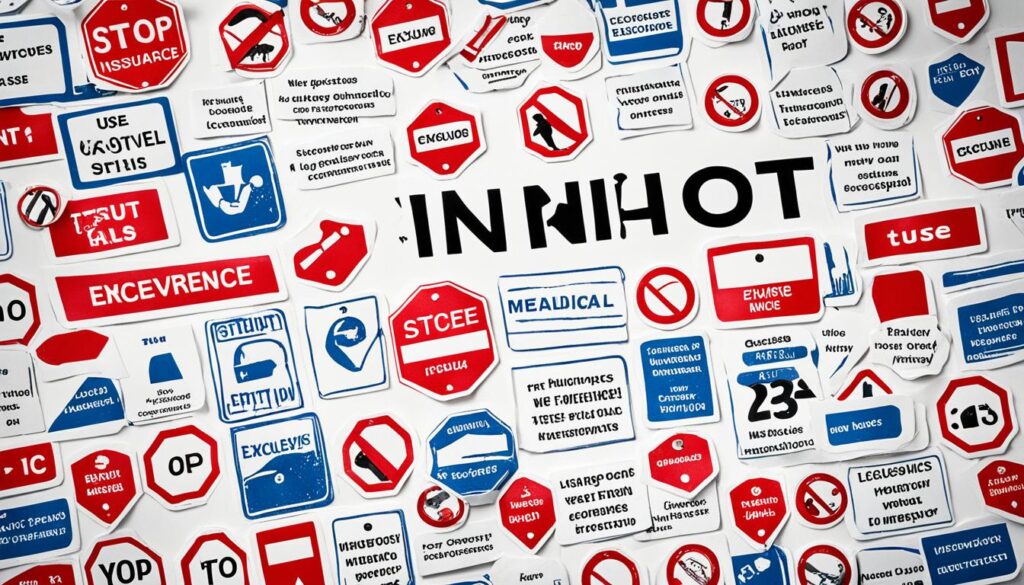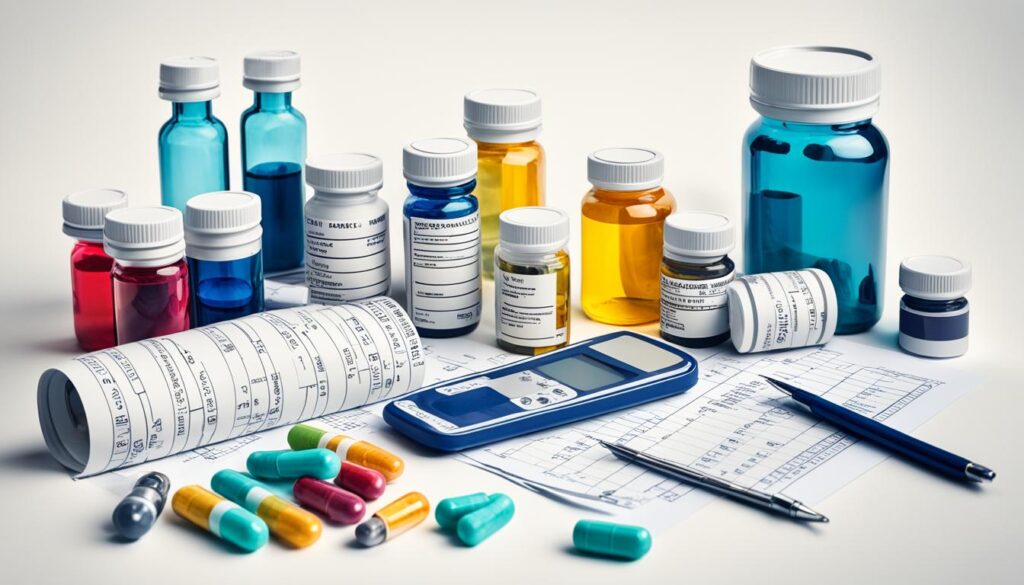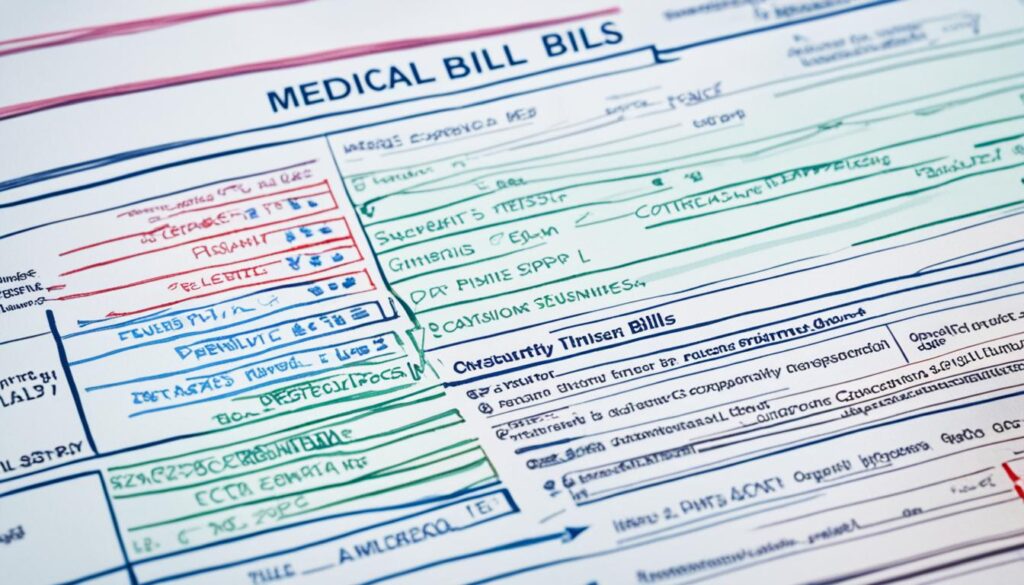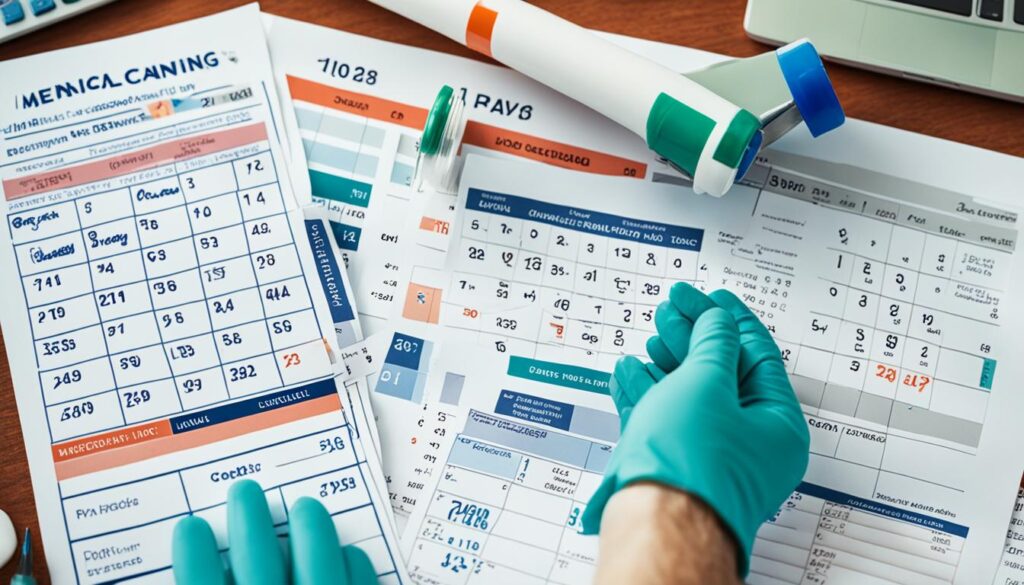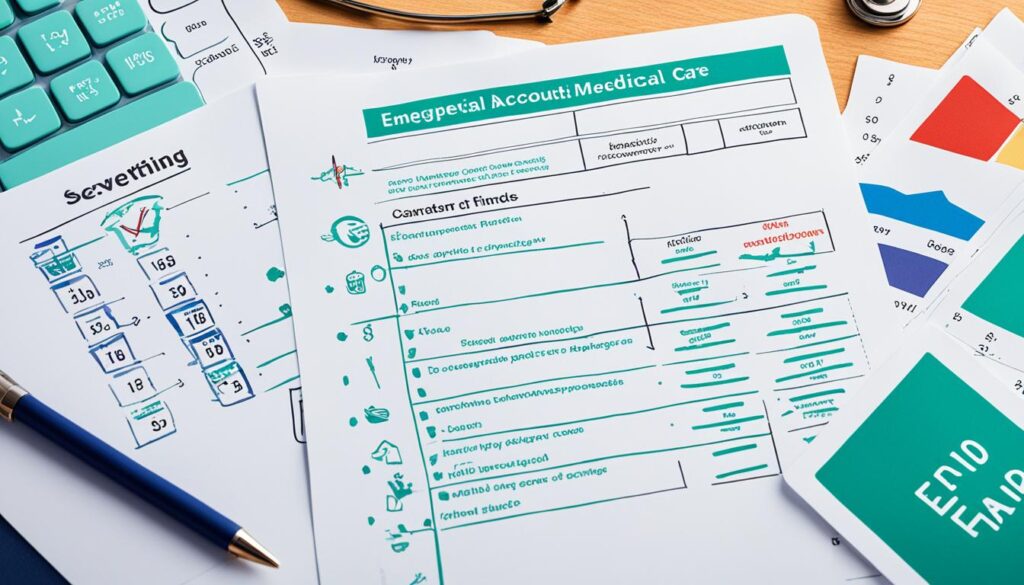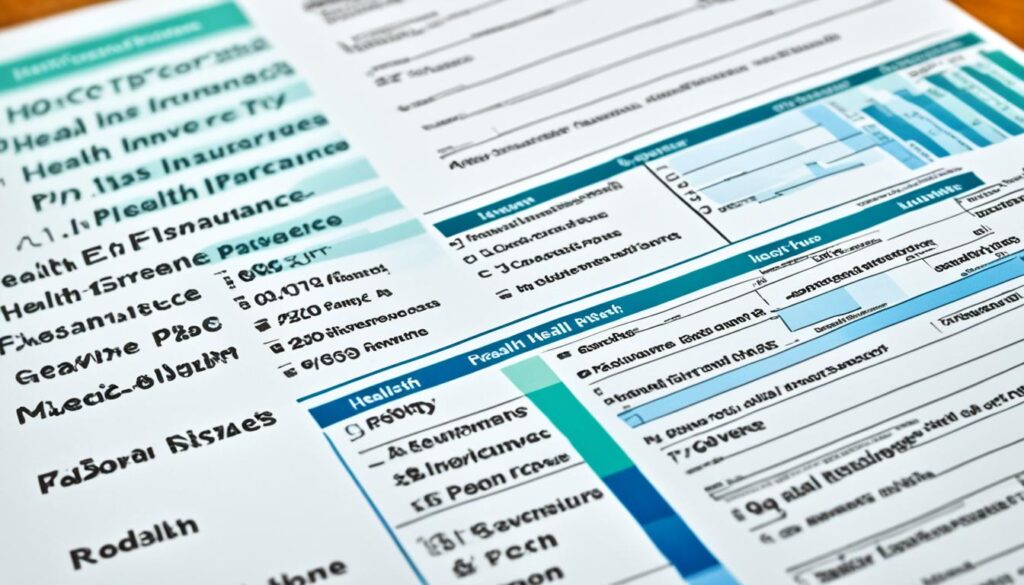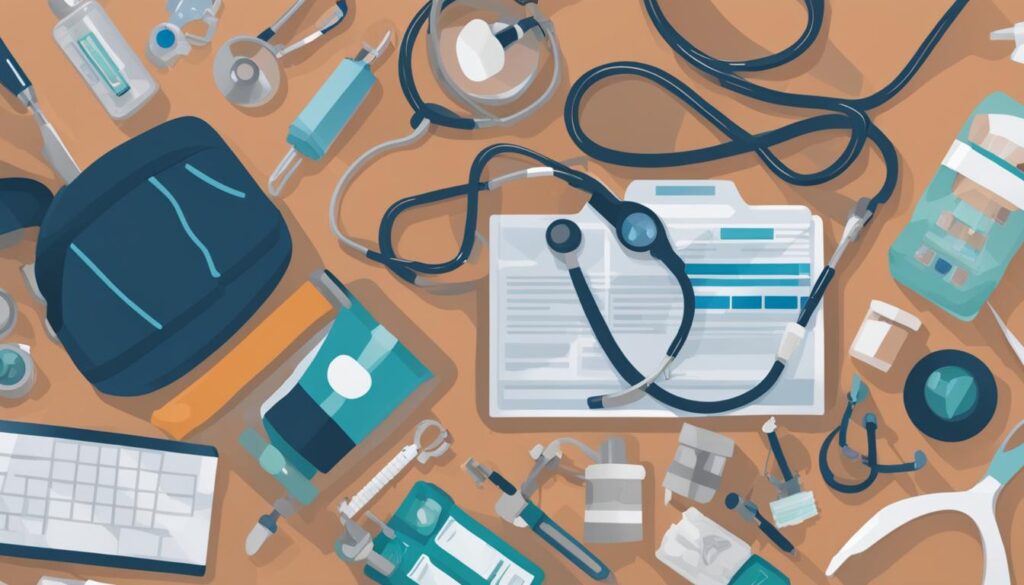Are you planning your next adventure? Don’t forget the importance of a travel first aid kit. It’s easy to miss, but a ready kit is key for minor injuries and emergencies. So, how do you prepare for any health issue you might face?
Discover what goes into a travel first aid kit. From needed medicines to bandages and useful tools. Find out how a stocked kit gives you peace of mind, letting you enjoy your travels fully.
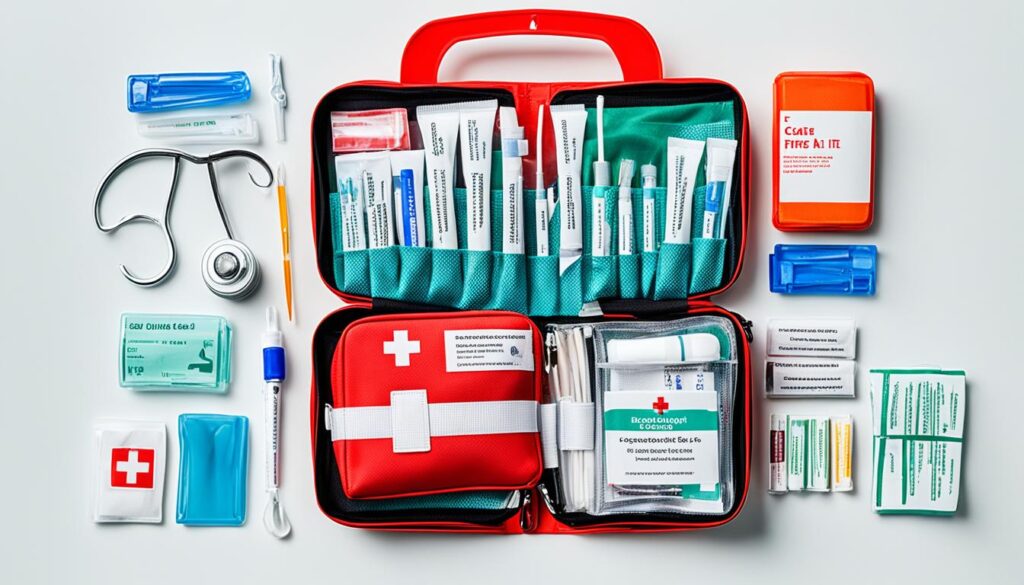
Key Takeaways:
- Preparing a travel first aid kit is essential for handling common injuries and emergencies while on the go.
- Pack essential medications, bandages and wound care supplies, and tools and accessories in your travel first aid kit.
- Consider including additional items like sunscreen, insect repellent, hand sanitizer, masks, and water purification tablets for overall travel health and safety.
- Follow tips for packing a DIY travel first aid kit to ensure efficiency and organization.
- Regularly maintain and update your travel first aid kit to keep it fully stocked and effective.
Why You Need a Travel First Aid Kit
A travel first aid kit is essential for anyone on the move. It has everything you need for minor injuries and illnesses. It keeps you safe and gives you peace of mind while travelling.
Ensuring Your Safety and Well-being
Accidents and health issues can pop up unexpectedly on trips. A travel first aid kit has tools and meds to help right away. It helps you take care of issues fast, keeping you healthy and safe.
“A travel first aid kit is like having a portable pharmacy and medical clinic in one, ensuring you have the means to attend to various health needs while away from home.”
Immediate Relief and Prevention of Complications
With a travel first aid kit, you can quickly handle injuries and sickness. It lets you treat a cut, ease a headache, or deal with indigestion fast. This helps you feel better sooner and prevents more problems.
Peace of Mind During Your Trip
One of the best things about having a travel first aid kit is feeling calm and prepared. You won’t worry about medical help in new places. You’re ready for common health issues, so you can fully enjoy your adventure.
Essential Medications for Your Travel First Aid Kit
When you pack for a trip, don’t forget your first aid kit. It’s important to have medications for common health problems. This will help with minor issues and make your travels smoother.
In your first aid kit, you should have:
| Medication | Use |
|---|---|
| Pain relievers (such as acetaminophen and ibuprofen) | To alleviate headaches, muscle aches, and reduce fever. |
| Antihistamines | For allergy relief and to manage symptoms like sneezing, itching, and runny nose. |
| Antacids | To ease heartburn and indigestion that may be caused by unfamiliar foods or changes in diet. |
| Anti-nausea or motion sickness medications | To prevent or alleviate symptoms of motion sickness during travel. |
| Antiseptic ointments | To treat minor wounds, cuts, and scrapes, reducing the risk of infection. |
If you have chronic conditions or need prescription meds, pack enough for the trip. Keep these medicines in their original containers. This avoids problems at security checks.
Over-the-counter (OTC) versus Prescription Medications
Knowing the difference between OTC and prescription meds is helpful for your travel kit.
Over-the-counter medications: These can be bought without a doctor’s note. They’re generally safe for treating common minor ailments.
Prescription medications: You need a doctor’s prescription for these. They are tailored for individual medical needs and should be used as directed by a healthcare professional.
It’s important to pack both OTC and prescription medications in your kit. Pack enough of your prescribed medicines.
Check the expiration dates on your medications regularly. Replace them as needed to ensure they’re effective.
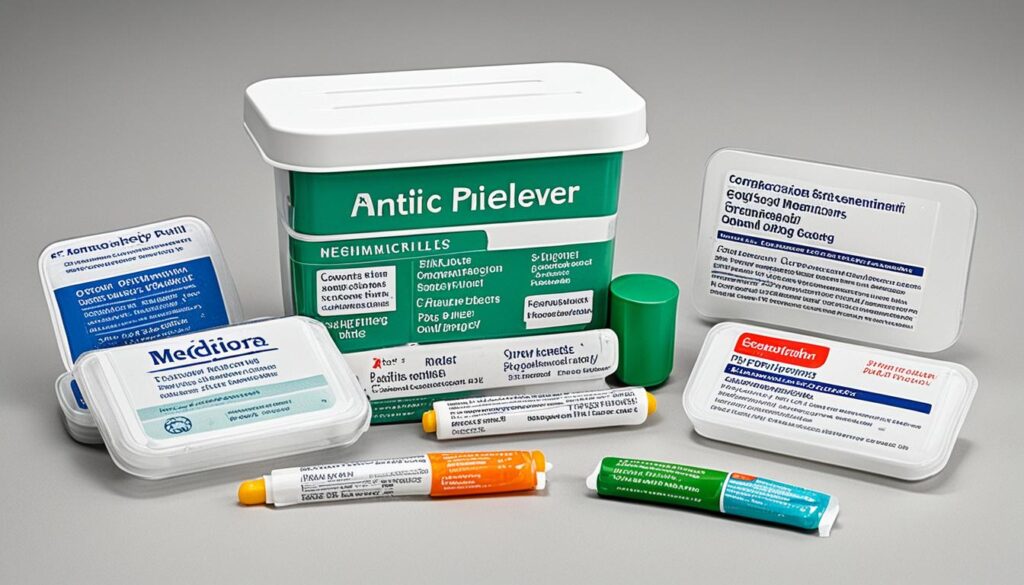
Having a well-stocked first aid kit means you’re ready for common health issues on your trip. This allows you to enjoy your travels with less worry and discomfort.
Bandages and Wound Care Supplies
Injuries can occur anytime, so keep bandages and wound care supplies in your travel kit. It’s vital to clean and dress wounds to avoid infections and heal faster. Make sure to pack these essentials:
1. Adhesive Bandages
Put different sizes of adhesive bandages in your kit. They work well for small cuts, scrapes, and blisters. Look for ones that stick well and can withstand activities.
2. Bandage Closures
Butterfly closures, or adhesive strips, hold deep cuts together. They reduce scarring and help wounds heal quicker.
3. Gauze Pads
Gauze pads are crucial for big wounds. They soak up extra moisture and keep the wound clean. Have various sizes ready for different wounds.
4. Adhesive Tape
You’ll need adhesive tape to keep gauze pads in place. Choose a hypoallergenic tape that sticks well but is gentle on skin.
5. Scissors
A small, sterile pair of scissors is a must in your kit. They’re used for cutting tape, gauze, and even clothes when necessary.
With these bandages and supplies in your first aid kit, you’re set to treat minor injuries on the go.
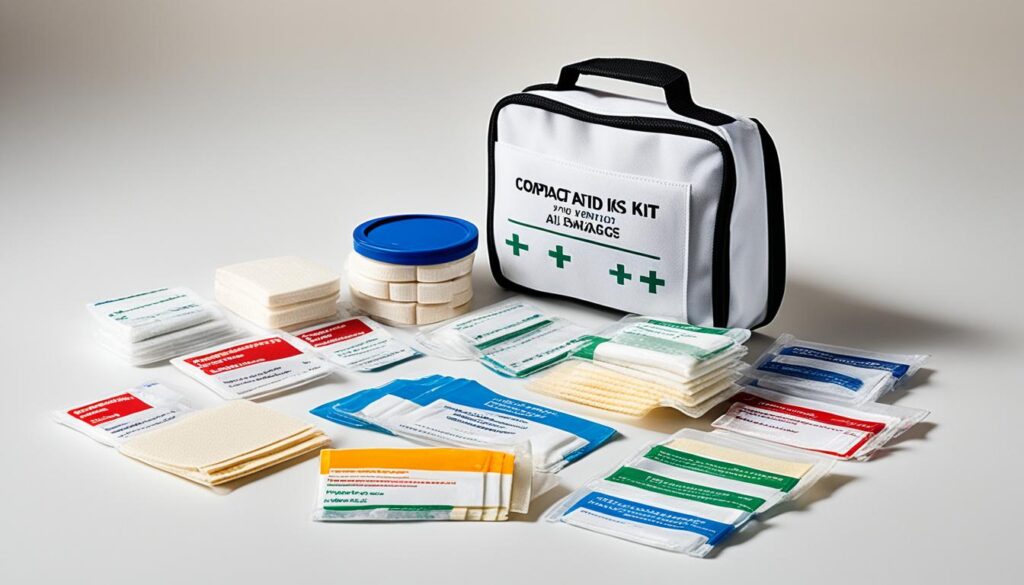
Tools and Accessories for Your Travel First Aid Kit
Getting ready for a trip means packing a first aid kit. It’s not just about the medical stuff. You also need tools and accessories. These help with various issues you might face on your journey. Consider adding these important items:
- Tweezers: Perfect for pulling out splinters, ticks, and other pesky things stuck in your skin.
- Thermometer: It’s crucial for checking if you have a fever or other signs of illness.
- Scissors: Small, sharp ones are best. They cut tape, gauze, or even clothes when necessary.
- Gloves: Use disposable ones to keep things clean and germs at bay when giving first aid.
- Safety pins: They’re great for keeping bandages in place, especially when you can’t use adhesive.
- Breathing barrier: This key item protects you and whoever you’re helping during CPR.
Adding these tools to your kit makes you ready for lots of medical issues. These items are vital. They help with everything from dealing with a splinter to checking for fever.
Make a list that includes these tools, medicines, bandages, and things for wounds. This way, your kit will be complete. You’ll be ready for anything that comes your way.
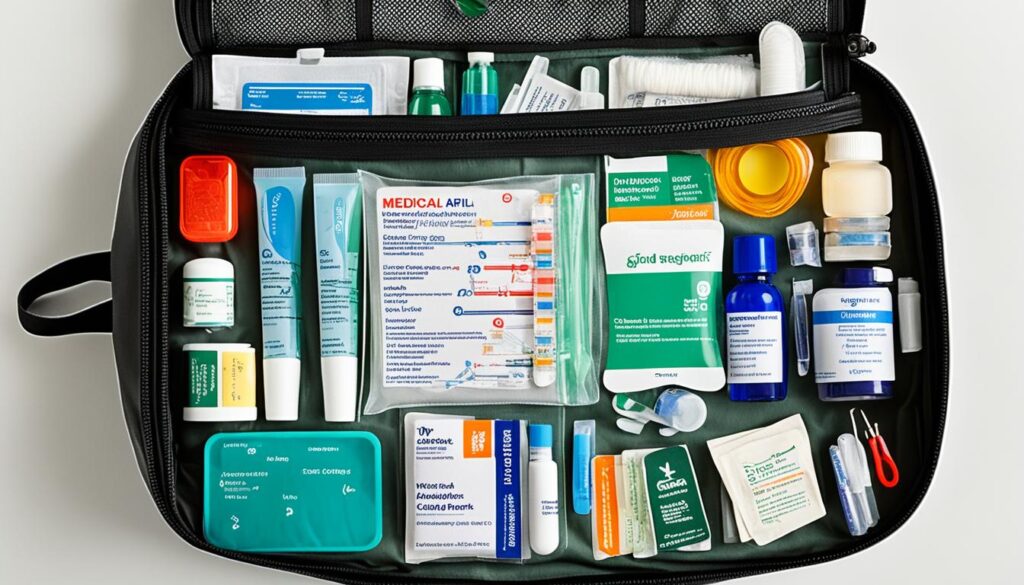
Pack with Care and Stay Ready
Having a full travel first aid kit is a big help on trips. But remember, it shouldn’t be too big or heavy. Choose small tools and ones that do lots of jobs. This saves space but keeps you prepared.
Remember to create a checklist that includes these tools for your travel first aid kit along with essential medications, bandages, and wound care supplies to ensure your kit is comprehensive and ready for any situation.
By packing the right tools and accessories, you can relax knowing you’re prepared. It’s good to be set for any injuries or emergencies. Stay safe and always be ready!
Additional Items for Travel Health and Safety
When you’re traveling, it’s key to keep your health and safety in check. Add extra items to your first aid kit to stay safe. These items help with common problems like sunburn, bug bites, and germs. Pack them to make your trip worry-free and focus on your health.
Travel Health Essentials
Think about adding these to your travel kit:
- Sunscreen: For skin protection, include sunscreen with a high SPF.
- Insect Repellent: Use reliable insect repellent to avoid annoying bugs.
- Hand Sanitizer: Keep your hands clean with sanitizer that has at least 60% alcohol.
- Masks: Masks are key in crowded places to avoid getting sick.
- Water Purification Tablets: Pack these to make sure your drinking water is safe.
Adding these items to your kit will shield you from health issues on your trip. This ensures a safe, healthy journey.

Tips for Packing a DIY Travel First Aid Kit
Packing a DIY travel first aid kit can be easy with the right tips. Whether it’s a quick trip or a long journey, a prepared first aid kit is essential. It offers peace of mind and ensures you’re ready for minor injuries or health issues.
Make a Checklist of Essential Items
Start by making a checklist of items you need. This will ensure you have everything for common injuries and ailments. Think about where you’re going and what you’ll be doing.
Opt for Compact and Travel-Sized Versions
Choose compact, travel-sized medications and supplies. Opt for portable blister packs and small bandages. This saves space and keeps your kit light.
Check Expiration Dates and Replace Accordingly
Check all expiration dates before you pack. Get rid of expired items. This guarantees your supplies are effective when needed.
Use a Waterproof and Durable Container
Use a waterproof, sturdy container for your kit. This protects your items from moisture and damage. Zip-lock bags are also great for smaller items.
With these tips, your DIY travel first aid kit will meet your needs. For extra advice, consult travel health resources or healthcare professionals.
Your first aid kit is crucial for your travels. Packing it well ensures you can tackle minor health issues confidently. This preparation will help you enjoy a worry-free journey.
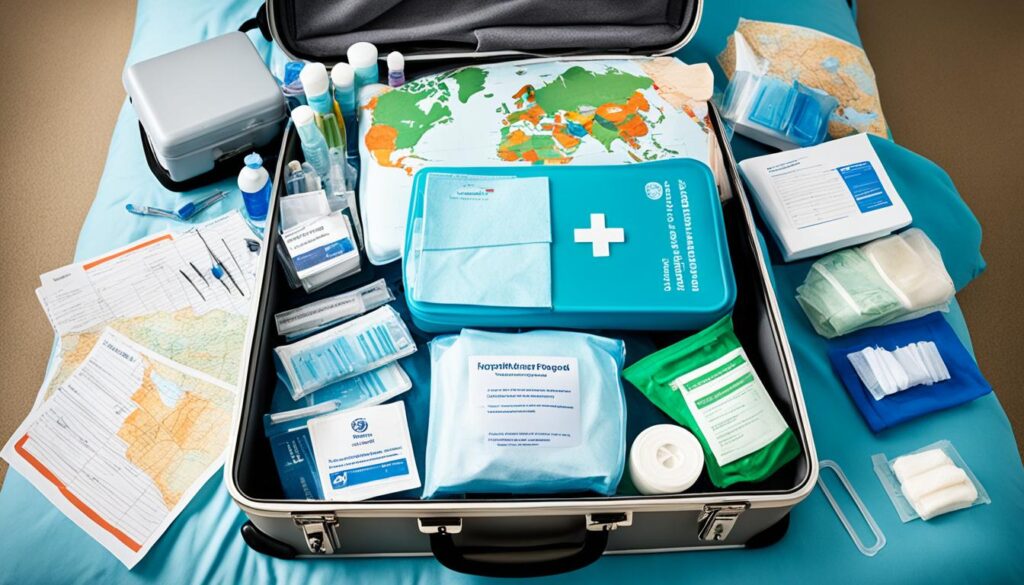
With your first aid kit packed, let’s head to Section 8. Here, we’ll learn how to keep your travel first aid kit effective on your trip.
Maintaining Your Travel First Aid Kit
Keeping your travel first aid kit up-to-date is key. Check the expiration dates on medicines often. Make sure to refill any items you’ve used or that have gone out of date. This keeps your kit ready for emergencies.
Also, think about where you’re going and what you’ll do there. Update your kit to match these plans. This way, you’re ready for any health issues that could come up.
Checking Expiration Dates
Checking your kit for outdated medications is important. If medicines are old, they might not work or could be unsafe. Replace any expired items to keep your kit safe and effective.
Restocking First Aid Supplies
It’s crucial to refill used or outdated items in your kit. This includes bandages, tape, antiseptic creams, and more. A well-stocked kit helps you manage minor health issues while traveling.
Reviewing and Updating Your First Aid Kit
Review and update your kit to meet your travel plans. Think about the activities you’ll do and update your kit accordingly. For example, add items like ankle braces if you’re going hiking. This ensures your kit can handle any problems you might face.
Maintaining your travel first aid kit is continuous work. Always check expiration dates, refill your supplies, and update your kit. This keeps it ready for emergencies or minor injuries.
| Tasks | Frequency |
|---|---|
| Check expiration dates of medications | Every 6 months |
| Restock used or expired supplies | As needed |
| Review and update your first aid kit | Before every trip |
Seeking Professional Medical Care
A travel first aid kit is good for minor injuries and illnesses. However, there might be times when seeking medical care while traveling is necessary. It’s vital to know how to find medical assistance abroad. Get to know the emergency medical services and healthcare facilities in the places you’re visiting.
When finding medical assistance abroad, keep these in mind:
- Look up local hospitals, clinics, and doctors early. This ensures you have options in an emergency.
- Check if your travel insurance includes emergency medical services. Write down any important contact details.
- Be aware of language differences. Carry a phrasebook or use translation apps for easier communication with healthcare staff.
If you get seriously injured or suddenly feel very sick, immediately seek medical assistance. It’s always safer to get checked by professionals quickly.
“In case of a medical emergency abroad, you should always contact the local emergency number immediately. They will guide you and send the right medical help.” – Dr. Sarah Thompson, Emergency Medicine Specialist
Emergency Medical Services Contacts
It’s important to know local emergency numbers when traveling abroad. Write down the emergency medical services contact numbers for the places you’re going to:
| Country | Emergency Medical Services Contact |
|---|---|
| United States | 911 |
| United Kingdom | 999 or 112 |
| France | 112 |
| Australia | 000 |
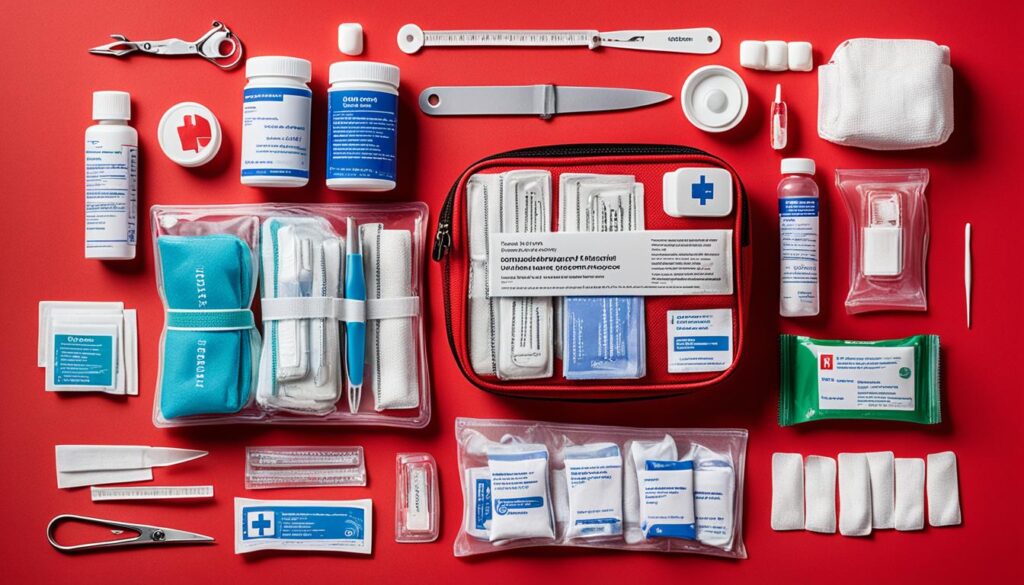
Final Thoughts on Travel First Aid Kits
Travel first aid kits are key for safe travel. They give you peace of mind by preparing you for injuries or emergencies. With essential supplies in your kit, you can enjoy your trip without stress.
When packing your kit, think about your health and where you’re going. Include things like medications and bandages that match your activities and health. This ensures you’re ready for anything.
Having a travel first aid kit is important for your safety. It lets you deal with minor issues on your own. If something big happens, it helps you get professional help fast. With this kit, you can travel with confidence.
FAQ
Why is it important to have a travel first aid kit?
A travel first aid kit is key for treating minor wounds and illnesses yourself. It provides quick relief and stops further health issues. It also lets you travel with less worry about finding help in new places.
What essential medications should I include in my travel first aid kit?
Your kit should have pain killers like acetaminophen and ibuprofen. It’s good to have antihistamines for allergic reactions and antacids for upset stomach. Include medication for nausea and antiseptic ointments too. Don’t forget any ongoing prescription meds.
What bandages and wound care supplies should I have in my travel first aid kit?
Pack different sizes of adhesive bandages, gauze pads, and bandage closures. Also, have adhesive tape and scissors. These help clean and cover wounds to stop infections and help healing.
What tools and accessories should I include in my travel first aid kit?
Your kit should have tweezers for splinters and ticks. Include a thermometer, scissors, gloves, safety pins, and a breathing barrier. These tools help you manage various situations and care needs.
What additional items should I pack for travel health and safety?
Think about packing sunscreen, insect repellent, hand sanitizer, masks, and water purification tablets. These protect you from sunburn, bugs, germs, and unsafe water.
What tips should I follow when packing a DIY travel first aid kit?
Create a checklist of the essential items. Choose travel-sized items and check expiry dates. Keep your kit in a waterproof and tough container.
How should I maintain my travel first aid kit?
Check and replace expired medications regularly. Restock used items. Change your kit based on where you’re going and what you’ll do there.
What should I do in case I need professional medical care while traveling?
Learn about local emergency services and hospitals where you’re going. If you get seriously sick or hurt, quickly seek help from professionals.
Why should I prioritize having a travel first aid kit?
Having a travel first aid kit is crucial for your safety and peace on trips. With the right supplies and upkeep, you’re ready for most minor emergencies. This lets you fully enjoy your journey.


